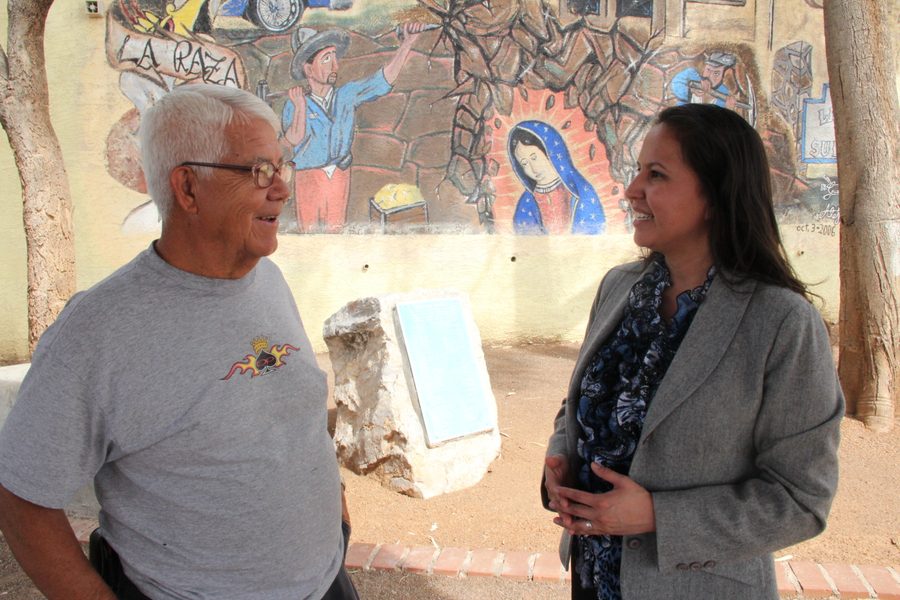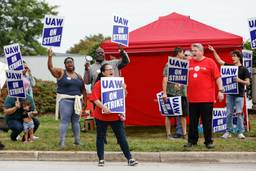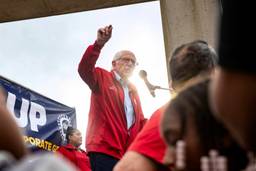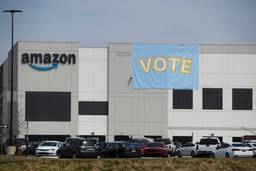
A note to readers: This and other recent Working In These Times articles by Kari Lydersen are drawn from her reporting for a forthcoming book on the history and resurgence of hard rock mining in Arizona and the Great Lakes region.
HAYDEN, ARIZ. — Stepping into the United Steelworkers hall in this town on March 24 brought back a flood of memories for Cecilia Cruz and her sister Carolina Cruz. Carolina had gone to school in the building back when Mexicans were segregated from whites and paddled for speaking Spanish. Cecilia worked a summer job there in a Head Start program, and went to school in the adjacent town of Winkelman. Both remembered romping in the playground as toxic clouds of dust and grit from the nearby copper smelter descended over the town, and splashing in the green water that ran off from the smelter.
The United Steelworkers union still represents workers at the smelter, now owned by Grupo Mexico. But the Steelworkers hall in Hayden is far from the bustling, vibrant nexus that union halls across the state’s “Copper Triangle” were in decades past. Only a few people came to meet Cecilia’s daughter-in-law, Wenona Benally Baldenegro, a Navajo lawyer who is running for Congress in Arizona’s First district. Earlier that morning, others struggled to find the Steelworkers hall in the nearby town of Kearny. I was also unable to find the correct hall for Wenona’s event there; I was given directions to a former union building that is now boarded up and overgrown with weeds.
Today many of the old mining operations have closed, and many that remain are no longer unionized, or unions’ power has been weakened. Cecilia Cruz notes that in the old days, when a political candidate like her daughter-in-law visited, the union hall would be packed and on Election Day members would loyally turn out in droves for the favored candidate. But despite their waning prominence in daily life, the rich and powerful history of the Steelworkers and other unions in the region remains… as the Cruzes and Cecilia’s husband Sal Baldenegro explained to me several days later at their home in Tucson.
“Labor history and Chicano history intersect. It’s the same history,” said Baldenegro, an icon of the Chicano rights movement and professor of Mexican American history at the University of Arizona. “Mexican Americans built these mining towns. Unions were the community, the vehicle, not only for union and civil rights issues, but for culture. They sponsored picnics, Christmas parties…”
“We would look forward to the union Christmas party, a big stocking full of fruit and candy, a gift for everyone,” added Cruz, who also has a long history in the Chicano rights, anti-war and women’s movements. “The union ran the volunteer firefighter auxiliary unit. The union held drives when someone was sick or needed help paying funeral expenses. The union was everything.”
Cruz’s father Roberto Cruz was one of the founders of the International Union of Mine, Mill and Smelter Workers Local 886, which later became the United Steelworkers Local 886. She showed me photos of her father and other workers surrounded by vintage pickup trucks painted with “Strike Relief Fund” for smelter workers in the nearby copper town of Miami.
She remembers how her father was tracked by FBI agents and called to testify before the House Un-American Activities Committee because of his union activism.
Mines and mining towns were segregated well into the middle of the last century. White workers and supervisors lived in the better houses in the nicer parts of town, and got better jobs and earned more underground than Mexican workers. Orlando Perea, a former miner who now lives in Superior, Ariz.„ remembers that Mexican workers were systematically paid $1 less per hour than white workers.
“If I trained a white guy, then he would be making $1 more than me,” Perea said, also remembering supervisors and town sheriffs regularly using slurs and insults to refer to Mexicans.
An historical website describes the legacy of discrimination in the “Copper Collar,” and the way brutal anti-union campaigns by government and company authorities continued through the 1980s:
Between World Wars One and Two, and into the 1950s, a pattern of separation and discrimination hardened in Arizona. The “Copper Collar” tightened as copper barons exerted their brand of industrial peace and progress. This involved structural discrimination in housing and jobs, as well as persistent surveillance and red-baiting. The famous (and famously black-listed) film “Salt of the Earth” portrayed the struggles of Mexican and Mexican-American miners and their families, including the women’s efforts to get the Mine, Mill and Smelterworkers Union to add indoor plumbing andhot running water to its strike demands. Both were available to Anglo families, but denied to Mexicans.
After moving from Texas at age seven, Perea grew up in the town of Sonora, Ariz. – one of three towns for workers at the Ray mine. The Mexicans lived in Sonora, Spaniards in the nearby town of Barcelona and whites in the town of Ray. (All three towns were eventually condemned and literally vanished as the open pit mine expanded and tore up that earth). Perea remembers Sonorans getting the discarded textbooks from the white school in Ray.
Another former miner from Superior, Tommy Macias, remembers that Mexican Americans were only allowed to swim in the town pool on the last day of the season, right before it was cleaned. “But we would swim in the creek, and that was better water anyway!” he laughed.
The historically white and Mexican sections of the town in Superior are still notably different, with the white neighborhood on the hill hosting larger homes, wider roads and sidewalks, while the Mexican area is right below the (now-defunct) smelter and waste pile from the mine.
They all agree that it was the unions – or rather the workers organized through unions — who successfully fought to end disparate pay and segregation.
“Equal pay for equal work,” said Perea. He remembered that sheriffs used to block the winding highway between the different mining towns to prevent organizers from mobilizing — so they would sneak through Devil’s Canyon, the beautiful rugged ravine lined with cactuses and cottonwoods — to hold meetings.
Cecilia and Carolina Cruz also remember how union organizers would sing a certain song over a mic from a pickup truck as a sign that a surreptitious meeting would be held.
As I’ve reported for In These Times before, there are strong and historical cross-border ties between Mexican and U.S. mine and steel workers, and last year the Steelworkers signed a formal solidarity agreement with the Mexican miners union (commonly known as Los Mineros).
Perea notes that workers — still unionized — at the Ray mine he worked at until last summer regularly send aid to the union miners in Cananea, Mexico, who have been on strike since 2007.
Many of the miners and civil rights activists lament that unions have faded so much in prominence and power these days, especially in a private industry like mining and a “right-to-work” state like Arizona. But the Cruzes and Baldenegro said the lessons and the gains of unions still live on in important if less obvious ways.
For example, their son Sal Baldenegro Jr. walked on picket lines and grew up hearing union war stories from his grandfather. Today, like his wife Wenona Benally Baldenegro. he is on the campaign trial, running for the state House of Representatives in Arizona, aiming to continue and expand upon the struggles of his parents’ generation.
Cecilia Cruz remembers her father and his cohorts standing on the tracks to literally block ore trains during strikes:
The legacy my father left behind was that you do not fear. Even standing in the tracks, you will make that train stop. My dad always said when you go into something, you go in to win. It was always a matter of ‘we will win, and we are in it to create change.
Full disclosure: The United Steelworkers union is a sponsor of In These Times.

I hope you found this article important. Before you leave, I want to ask you to consider supporting our work with a donation. In These Times needs readers like you to help sustain our mission. We don’t depend on—or want—corporate advertising or deep-pocketed billionaires to fund our journalism. We’re supported by you, the reader, so we can focus on covering the issues that matter most to the progressive movement without fear or compromise.
Our work isn’t hidden behind a paywall because of people like you who support our journalism. We want to keep it that way. If you value the work we do and the movements we cover, please consider donating to In These Times.
Kari Lydersen is a Chicago-based journalist, author and assistant professor at Northwestern University, where she leads the investigative specialization at the Medill School of Journalism, Media, Integrated Marketing Communications. Her books include Mayor 1%: Rahm Emanuel and the Rise of Chicago’s 99%.







